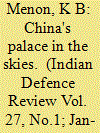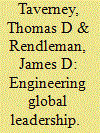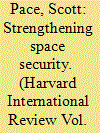| Srl | Item |
| 1 |
ID:
110168


|
|
|
| 2 |
ID:
108945


|
|
|
|
|
| Publication |
2011.
|
| Summary/Abstract |
The economic greatness that the United States achieved in the last half of the twentieth century was not assured at the end of World War II. The ascension and U.S. economic juggernaut was secured by three seminal events: (1) the passage of the G.I. Bill; (2) the Soviets' Sputnik launch and the start of the Space Age; and (3) John F. Kennedy's challenge to go to the moon and the subsequent Moon Race. These events spurred the United States to seize and retain leadership in space technology development and space activities; the nation invested in education systems and students, and encouraged a competition that brought out the best from its engineers and scientists and inspired important efforts. The resulting technical genius has fostered advances in a wide variety of other technologies, improving the nation's quality of life. The United States now faces a difficult road ahead unless something is done to reverse recent downward trends in science, technology, engineering, and math education. The authors ask: where is our next G.I. Bill, Sputnik, or Moon Race?
|
|
|
|
|
|
|
|
|
|
|
|
|
|
|
|
| 3 |
ID:
119886


|
|
|
|
|
| Publication |
2011.
|
| Summary/Abstract |
Fifty years ago, the Space Age was not yet five years old but the broad outlines of US space interests were visible. The year 1962 saw the first US human orbital flight by John Glenn on a converted Atlas Intercontinental Ballistic Missile (ICBM). Telstar 1 demonstrated the first transatlantic television, telephone, and fax transmissions by an active satellite. The United Kingdom became the third country to operate a satellite with the US launch of Ariel 1. Later that year, both Telstar 1 and Ariel 1 were seriously damaged when the United States detonated a 1.4-megaton nuclear device 250 miles over the Pacific Ocean in what was titled the Starfish Prime test. The Glenn flight and the Starfish Prime test respectively represented the civil and military bookends of US space interests that were to shape international, commercial, and scientific space activities.
|
|
|
|
|
|
|
|
|
|
|
|
|
|
|
|